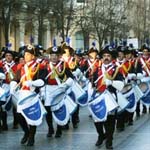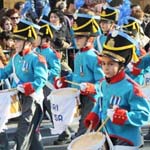San Sebastian's Tamborrada
Every year the people of the beautiful San Sebastian gather around at the Constitution Square, an emblematic spot in the old town quarter, on the evening of January 19th for the city’s big day of celebrations. The feast consists in a 24-hour non-stop band drumming performed by the many different drummer bands in the city.
Origin
Legend has it that in 1720 a baker was filling up water barrels at one of the three fountains that supplied the city with water. While he was fetching the water, he began to sing, and a group of girls and servants that were waiting the line for the fountain, started banging on their basins to accompany the singing. This is the mythical origin of San Sebastian's Tamborrada.

More probable is the fact that, during the sieges that the city suffered at the end of the XVIII century, the locals mocked the soldiers by imitating their marches, an event which eventually developed into a youth music group that performed in the city’s Carnival festivity.
Either is possible, so just choose the one that sound more interesting, captivating, or rational to you! As it usually happens with Spanish fiestas and traditions, they usually have a twisted origin very hard to trace back.
What’s definitely a fact is that the song that the original society (each of the tamborradas, or associations of drummers) played at the opening act of the feast was the “Sheshenarena”, since the one played today, the “March of San Sebastian” wasn’t composed by maestro Sarriegui until 1860. Today, the bands play the compositions of the master Raimundo Sarriegui, who, apart from the “March of San Sebastian” (the lyrics of which were written by Serafín Baroja, father of famous novelist Pío Baroja), wrote many other pieces for drums and percussion instruments.
Celebration
The participants are divided in three groups: the tamborreros (the ones who play the drum), the cooks and the water carriers. These last two groups play similar sounding instruments; the former play a barrel, and the latter play water basins.
In the early times, people dressed in fancy costumes, all of them different from one another, but it was then established that the tamborradas should wear some kind of uniform. Nowadays, the tamborreros dress in military costumes from the Napoleonic times, and the cooks dress as cooks (sic).
The party begins on the night of January 19th, when the city’s flag is hoisted at the Constitución Square. This is the moment when the Gaztelubide society starts playing the “March of San Sebastian”, the grand opening of the celebration. From this moment until the midnight of the next day, January 20th, there is a continuous playing of drums and barrels in every corner of the city.

On the morning of the 20th takes place the children’s Tamborrada, that also goes around town, and at the end of which a General and a Bella Easo (Beauty) are elected from the participants. The first time it was held was in 1961, and nowadays more than 50 companies, each representing a school and also wearing different uniforms, take the streets of San Sebastian on this date.
At midnight, after the 24 hour drumming marathon, the companies gather at the place where it all began, the “Constitución” Square, around the “Unión Artesana” company –the oldest “company” in town-, which, at the lowering of the city’s flag, plays the complete repertoire of Sarriegui before they perform the "March of San Sebastian" as the closing piece of the feast.
During these 24 hours, many awards are also given out, like the Golden Drums, and the five Medals to the Citizen merit. They usually go to a celebrity or someone who has positively and acknowledgedly contributed to the city’s betterment and its people’s.
So, if you are planning on attending San Sebastian's Tamborrada, just remember one thing: Don’t forget your earplugs!

 For all of you drum lovers, make sure you don't miss the drumming marathon that floods the beautiful city of San Sebastian. Drum roll, please!
For all of you drum lovers, make sure you don't miss the drumming marathon that floods the beautiful city of San Sebastian. Drum roll, please! 